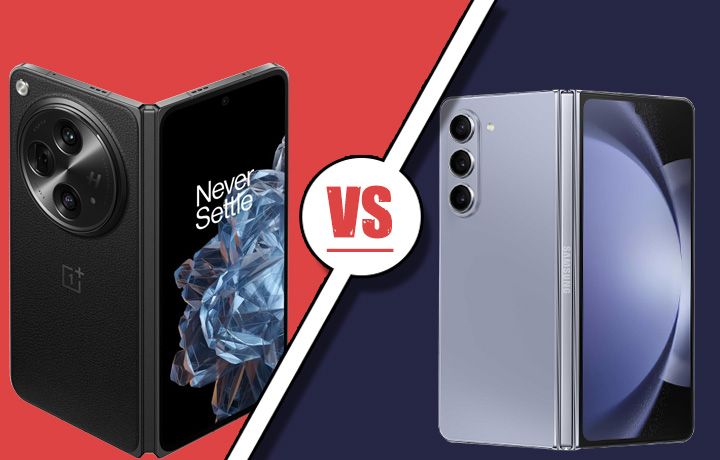OnePlus Open vs. Galaxy Z Fold 5: A Detailed Comparison
The smartphone industry is no stranger to intense competition, and the foldable phone market is no exception. In this comparison, we will delve into the OnePlus Open and the Galaxy Z Fold 5, two formidable contenders in the foldable phone arena.
The statement “this is the OnePlus open, and hands down this is exactly what the Galaxy Z Fold 5 should have been this year” sets the stage for a detailed examination of these two devices. The argument made is clear: OnePlus Open has made a strong entry into the foldable phone market, offering a design and features that outshine its competitor, the Galaxy Z Fold 5. Check out their latest prices here: OnePlus Open and Galaxy Z Fold 5.
- Read also:
- Google Pixel Fold Review
- OnePlus Open Review
Design and Build
Design and build quality are significant factors in a foldable phone’s appeal. OnePlus Open’s design, while sharing some similarities with the Galaxy Z Fold 5, offers subtle improvements. The gap when the phone is closed is less pronounced, and button placement is slightly different, with the power button and volume rocker positioned a bit lower. OnePlus Open also features an alert slider, a favorite among OnePlus users, allowing quick changes between ring, vibrate, and silent modes.
OnePlus Open also brings an exciting addition to its design with triple speakers, offering superior audio quality. In contrast, the Galaxy Z Fold 5 has two speakers, giving OnePlus Open an edge in the sound department.
Both phones feature frosted backs, reducing fingerprint smudges and providing a more grippy texture. This design choice improves the overall user experience, especially when handling the device one-handed. OnePlus Open’s slight advantage in design elements makes it a more appealing choice for those who value small but impactful improvements.
Cover And Internal Displays:
Cover Display: Size and Technology: The cover display is a crucial aspect of foldable phones since it’s the primary interface for most interactions. OnePlus Open impresses with its cover display, boasting a 6.3-inch size compared to the Galaxy Z Fold 5‘s 6.2-inch display. A slightly larger screen may not seem significant, but in practice, it can greatly impact user experience. When using the cover display for tasks like texting, browsing, or even quick productivity tasks, every bit of screen real estate counts. This extra space on the OnePlus Open allows for more comfortable and efficient use of the device.
However, size isn’t the only factor at play. The technology powering the display is equally essential. OnePlus Open utilizes an LTPO (Low-Temperature Polycrystalline Oxide) screen that can dynamically adjust its refresh rate from 1 to 120 Hz. This feature enhances battery life and provides a smoother user experience.
In contrast, the Galaxy Z Fold 5 has a 120 Hz display, but it lags behind in peak brightness at 1750 nits compared to OnePlus Open’s 2400 nits. The brightness advantage, combined with adaptive refresh rates, gives OnePlus Open a significant edge in terms of display technology on its cover screen.
Internal Display Quality and Crease: The internal displays of foldable phones are the star attractions. OnePlus Open sports a 7.82-inch display, while the Galaxy Z Fold 5 offers a slightly smaller 7.6-inch display. The difference in size may not be substantial, but it impacts various aspects of usability, from content consumption to multitasking. OnePlus Open’s design choice results in a slight tilt when the phone is open, primarily due to its high camera bump. The Galaxy Z Fold 5 offers a more level display.
Both devices feature anti-reflective coatings on their displays, with OnePlus Open’s implementation being more effective in reducing reflections. The OnePlus Open’s matte-like display quality enhances outdoor visibility and minimizes the appearance of the crease, making it more appealing when used in bright conditions. In contrast, the Galaxy Z Fold 5’s crease can be more noticeable due to its glossier display.
Camera Quality
Camera quality is often a decisive factor for smartphone buyers. OnePlus Open and Galaxy Z Fold 5 take different approaches to their camera systems. OnePlus Open boasts a considerable 48-megapixel wide lens, a 64-megapixel three-times optical telephoto lens, and a 48-megapixel ultra-wide lens. Meanwhile, the Galaxy Z Fold 5 features a 50-megapixel wide lens, a 10-megapixel three-times optical lens, and a 12-megapixel ultra-wide lens.
Despite the OnePlus Open’s impressive hardware and the Hasselblad branding, it surprisingly falls short in delivering consistent image quality. In several tests, Galaxy Z Fold 5 displayed better color accuracy, exposure control, and overall image quality. OnePlus Open’s camera system is not without its merits, particularly when it comes to dynamic range. However, the inconsistency in image output is a concern, and OnePlus needs to refine its camera tuning to match its competitors.
The front-facing camera on OnePlus Open is a substantial 32 megapixels, providing the potential for excellent selfies and video calls. In comparison, the Galaxy Z Fold 5 has a 10-megapixel front camera, which may impact the quality of selfies and video calls.
Nighttime photography on both devices showed subtle differences. OnePlus Open tended to produce more natural-looking low-light photos, while Galaxy Z Fold 5 favored a more vibrant and brighter appearance. The choice between the two depends on personal preferences in night photography.
Video quality is a close match, with both devices producing respectable 4K 30fps videos. However, the Galaxy Z Fold 5 tends to have a more appealing look with a contrastier style and bluer skies.
- Check out these as well:
- Lenovo Tab Extreme Review
- Samsung Galaxy Tab S9 Ultra vs. Galaxy Tab S8 Ultra
Software and User Experience
Software plays a crucial role in foldable phone experiences, and here’s where the Galaxy Z Fold 5 shines. Samsung has more experience in the foldable phone market, and it shows in the software features and optimizations.
One notable feature is the ability to have different setups for the cover screen and the inner screen. This allows users to customize their experience for different scenarios, enhancing overall versatility. OnePlus Open, in contrast, maintains the same layout for both screens, which might not fully utilize the larger inner display’s potential.
Both devices support split-screen functionality, but the Galaxy Z Fold 5 introduces a more extensive array of multitasking features. It’s also capable of converting into a desktop-like experience, making it a versatile tool for productivity.
OnePlus Open may excel in hardware, but the Galaxy Z Fold 5’s software optimizations provide a more polished and user-friendly experience, especially for multitasking and customization.
Additional Features
Some additional features set the two devices apart. Galaxy Z Fold 5 offers water resistance with an IPX8 rating, making it more resilient against accidental splashes or exposure to moisture. In contrast, OnePlus Open has an IPX4 rating, which only provides splash resistance. This difference might be significant for users who prioritize water resistance in their devices.
OnePlus Open lacks wireless charging, which could be a drawback for users who rely on this convenient charging method. On the other hand, it compensates with SuperVOOC 67W fast charging, providing a rapid way to replenish the battery.
Battery Life and Charging
Battery capacity is crucial in foldable phones, as they power larger displays and more demanding tasks. OnePlus Open features a 4800mAh battery, surpassing the Galaxy Z Fold 5’s 4400mAh capacity. This larger battery, combined with efficient hardware and software optimizations, gives OnePlus Open an advantage in battery life.
Additionally, OnePlus Open supports SuperVOOC 67W charging, allowing for quick top-ups. In comparison, the Galaxy Z Fold 5’s wireless charging is limited to 25W, offering a slower charging experience.
- Xiaomi Pad 6 Max 14 Review: A Gaming and Media Powerhouse
- iPhone 15 vs iPhone 14: Which iPhone Should You Choose?
Price and Trade-In Offer
Pricing plays a critical role in consumer decisions, and OnePlus Open has positioned itself competitively. The price of $1699 may appear steep, but there’s a compelling offer for potential buyers. OnePlus allows users to trade in any old phone, regardless of its condition, providing an automatic $200 credit towards the OnePlus Open. This effectively reduces the cost of the device to $1499, making it more accessible to a broader range of consumers.
However, it’s worth noting that the Galaxy Z Fold 5’s price wasn’t provided for comparison in the original statement, making it challenging to evaluate the cost-effectiveness of OnePlus Open fully. Nevertheless, the trade-in option offered by OnePlus Open is a generous and customer-friendly approach. Check out their latest prices here: OnePlus Open and Galaxy Z Fold 5.
Conclusion
The OnePlus Open and Galaxy Z Fold 5 represent formidable entries into the foldable phone market. OnePlus Open impresses with its cover display size, technology, and overall hardware prowess. It offers an exceptional user experience, especially for those who prioritize display quality and battery life.
However, the Galaxy Z Fold 5 excels in software optimization, providing a more polished and versatile user experience. It also boasts water resistance, wireless charging, and a more refined camera system.
Ultimately, the choice between these two devices depends on individual preferences and priorities. OnePlus Open offers a compelling alternative for users seeking a superior display experience, while the Galaxy Z Fold 5 provides a more refined software ecosystem and additional features. Both devices have their strengths, and consumers should weigh these factors carefully before making a decision. Check out their latest prices here: OnePlus Open and Galaxy Z Fold 5.
- Shop On Amazon Using Our Links To Support Us:
- Buy Garmin Venu 3 – Amazon under $25 – Buy Honor 90
- Amazon best sellers – Amazon most gifted – Corocs Pace 2






